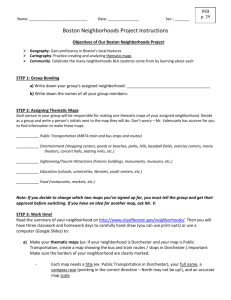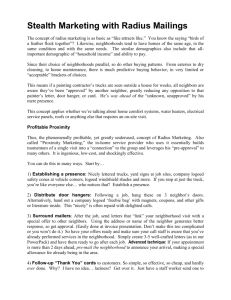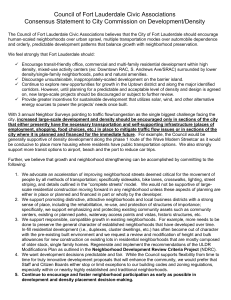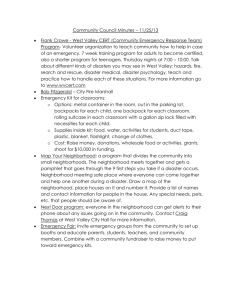DOCX - National Neighborhood Indicators Partnership
advertisement
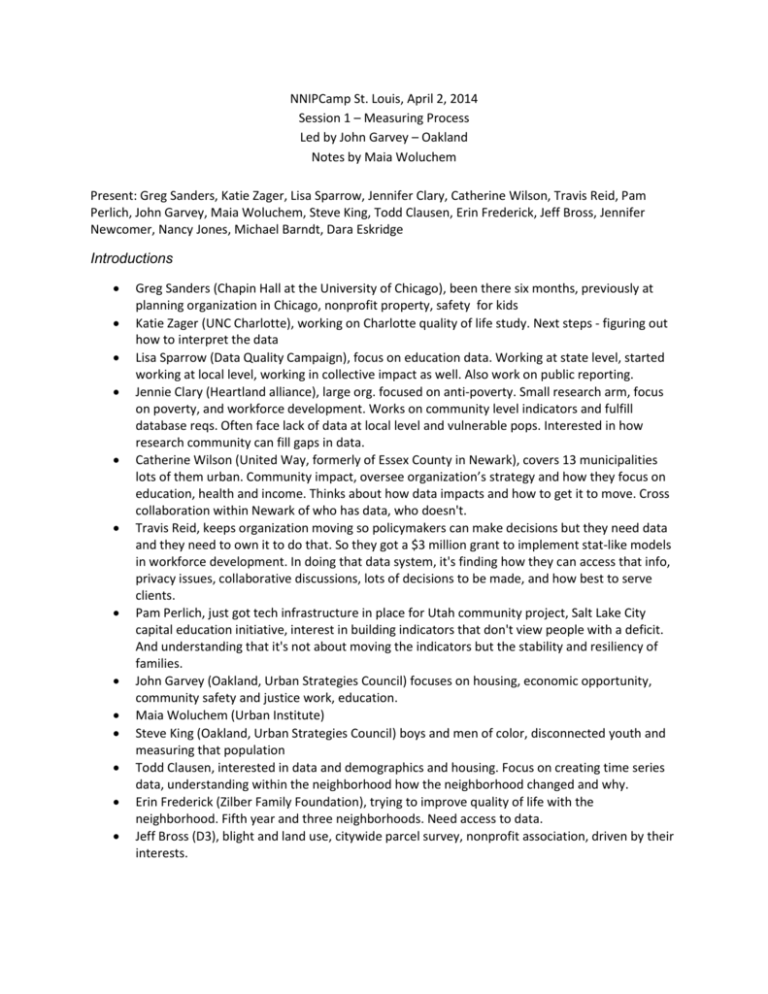
NNIPCamp St. Louis, April 2, 2014 Session 1 – Measuring Process Led by John Garvey – Oakland Notes by Maia Woluchem Present: Greg Sanders, Katie Zager, Lisa Sparrow, Jennifer Clary, Catherine Wilson, Travis Reid, Pam Perlich, John Garvey, Maia Woluchem, Steve King, Todd Clausen, Erin Frederick, Jeff Bross, Jennifer Newcomer, Nancy Jones, Michael Barndt, Dara Eskridge Introductions Greg Sanders (Chapin Hall at the University of Chicago), been there six months, previously at planning organization in Chicago, nonprofit property, safety for kids Katie Zager (UNC Charlotte), working on Charlotte quality of life study. Next steps - figuring out how to interpret the data Lisa Sparrow (Data Quality Campaign), focus on education data. Working at state level, started working at local level, working in collective impact as well. Also work on public reporting. Jennie Clary (Heartland alliance), large org. focused on anti-poverty. Small research arm, focus on poverty, and workforce development. Works on community level indicators and fulfill database reqs. Often face lack of data at local level and vulnerable pops. Interested in how research community can fill gaps in data. Catherine Wilson (United Way, formerly of Essex County in Newark), covers 13 municipalities lots of them urban. Community impact, oversee organization’s strategy and how they focus on education, health and income. Thinks about how data impacts and how to get it to move. Cross collaboration within Newark of who has data, who doesn't. Travis Reid, keeps organization moving so policymakers can make decisions but they need data and they need to own it to do that. So they got a $3 million grant to implement stat-like models in workforce development. In doing that data system, it's finding how they can access that info, privacy issues, collaborative discussions, lots of decisions to be made, and how best to serve clients. Pam Perlich, just got tech infrastructure in place for Utah community project, Salt Lake City capital education initiative, interest in building indicators that don't view people with a deficit. And understanding that it's not about moving the indicators but the stability and resiliency of families. John Garvey (Oakland, Urban Strategies Council) focuses on housing, economic opportunity, community safety and justice work, education. Maia Woluchem (Urban Institute) Steve King (Oakland, Urban Strategies Council) boys and men of color, disconnected youth and measuring that population Todd Clausen, interested in data and demographics and housing. Focus on creating time series data, understanding within the neighborhood how the neighborhood changed and why. Erin Frederick (Zilber Family Foundation), trying to improve quality of life with the neighborhood. Fifth year and three neighborhoods. Need access to data. Jeff Bross (D3), blight and land use, citywide parcel survey, nonprofit association, driven by their interests. Jennifer Newcomer (Piton Foundation), strategic planning process, focusing our assets to be in social return investment opportunities, defining neighborhoods in the regional scale, need to do things with new partnerships. Nancy Jones (BNIA), 100 data sets compiled to make the report and aggregated out to community members. Alleviates data collection. Strong ties to data providers. Special projects need a different MOU. Trying to do integrated data work with other NNIP partners. Trying to get weatherization data because of old housing stock. Coming in slowly and sloppily. Also looking at storm water runoff. Utility data is unavailable to them because of privacy. Two data providers retired this month, so that is bad. Michael Barndt (Milwaukee), challenge is that access to quality things like courts or education data is tough. Tendency to begin, to try to make that data available and not to see it as a community asset. How are black males doing in our city? Are we focused enough to know the total picture? Ok starting now-Garvey-- pretty half baked idea. Three things, trying to measure process. 1. We’re very much into indicators based on spatial patterns. We can draw understandings from the patterns but we’re really pattern oriented when we think about the whys. 2. Thinking about foreclosure really at a global scale and we're seeing patterns. How do we measure the process of change to get ahead of the curve and not wait to see the pattern that emerges? 3. Third part is about scale, collective impact and regionalism. Even if we're sticking with the patterns, the interaction with these patterns is increasingly important. All the external factors are important, so scale translation is super huge now as we're upping our game. Either look locally and try to guess globally or go the other way around. So housing is a mix between the market forces affecting our communities--cultural change, flow of capital, mix of policy between public agencies, decay rates of housing, banking and lending practices and also has a lot to do with style and culture. Causal measures of these agents. So is there a way to go upstream and look at processes that inform these things? I don't have much deeper thoughts on these topics, but can we measure the wind? Barndt—When we got hit with foreclosure, homeownership plummeted and no one seems to be particularly looking at impact and other important things. If we do the housing side, we can't do the human side, looking at family impact and the rest. What are we going to have to adjust to? I understand some cities had some opportunity—to what extent are you looking at other heavy hit cities and what the impact is going to be when coming out of that depression? Garvey—In Oakland we did do some analysis, measuring the wind. Had the universe of bad loans and knew the geography of that but still couldn't affect changes to a substantive level enough to stop it. In some sense, we are measuring the process but when can you act on that process? Especially with tough neighborhoods? Perlich (?)—If your unit is the household, think about the investments that households make in their children and how the spending patterns are made up of things. If things work well, you borrow when you’re young, you pay that off and have good assets when you are old. So this has wreaked havoc, because we don't have the social safety nets in place. We used to have some real inter-generational inequities and transfers that we expect going to younger generations but it doesn't go there anymore. You've got the huge overhang of debt and the political system that protects the rich holding the assets. Unless we can come up with a strategy that can get retiring baby boomers to request back into educational opportunities, we need to think about the family units and generations. Jones—We are loosely tracking foreclosures. One of our staffers pointed out that most of the foreclosures he was seeing were when lenders were accelerating the foreclosure because people were aging out of the home. So you could measure the process if you look at something other than the foreclosure. For example: Rehabilitation spending on the house, age of the householders, ETC. Perlich—Increasing inequality doesn't help you track equity. Financial position of individual households is good because inter-generational mobility rates are highest among families that are most economically resilient. Garvey—Employment, education and housing, there are things that have shown that there's an event, and that's something you can track. Do those same things work in education and employment? Right now we measure things like chronic absenteeism? Wilson--Very hard to get their data. Chronic absenteeism, we’re looking at over half of the kindergartners, and we don't have any data about why those kids have missed more than two months of school. High immigrant populations take their kids out of school to go to their native county. Much higher quality school opportunities are about to happen and reducing the amount of public housing. Educationally there's a lot going on. Will the education bring people? Will the housing bring people back? What struck me a bit about the St. Louis presentation is that we were assuming that the high population a going to lift people out of poverty. Travis—In workforce development, we don't have enough of an education discussion. There are not enough prepared qualified individuals to full those job openings that are available. When you realize you have an educational model—for us, it's trying to have a discussion at the Department of Labor. What are the long-term questions about getting work between workforce development and education together? Garvey—Impact of particular interventions on kids, like indicators for arrest records, becoming a data mining problem Woluchem—For our DC Promise Neighborhood, we collect information about the family and the household itself—things like whether the mother is educated, how many other kids are in the house, whether the family is food insecure, and as it turns out, these are all factors that play into the education of the child in the school. It is often less to do with the child itself than with the surroundings. Barndt—Making Connections is another great example of this. Jones—Speak of tools - we're not measuring perceptions, but do you do surveys? Wilson—The promise survey talked about perceptions a lot. The local school has a thirteen percent neighborhood reading level. But 95 percent of adults thought that was a high performing school. Huge disconnect between people who make decisions and then people who are actually living there. They have programs there but they also feel safe there. Sparrow—And that's true nationally. That's pushback against the common core. Dara Eskridge (St. Louis planning)—The idea of perception from community members is very different from planners and professionals believe. We did a sticky board and people were shocked. Surveys are important. Clausen—Really hate planning meetings that community members go to. We come in with a preconceived notion of what the community wants. We don't give them the option of providing their ideas. Fellow Milwaukee guest—In our NeighborWorks projects, success measurements, they have results across neighborhoods. We did that with the three neighborhoods across things like that. Residents do the property assessments. They are perceptions, but real estate professionals are the ones that write the book. Garvey—We have a tough time convincing them to do things. The business owners really impact Oakland too. Barndt—Business perceptions of safety is important. Misperceptions by residents often counter business. Why aren't we seeing that the neighborhood gets to learn more about whether the things that matter are really happening in their school or in their neighborhood? We've been tested to talk about crime data because of their sense of safety. You need to use data to reduce the disconnect between perception and reality. One way of thinking about it is not just thinking about the perceptions but the models people use. What's your framework? Theory of change is good but there are lots of models in peoples’ head that don't get articulated that often. The neighborhood starts to get in sync with what's happening with someone's neighborhood and they need to think about what's going on outside their neighborhood. They have to make the vertical connections.


